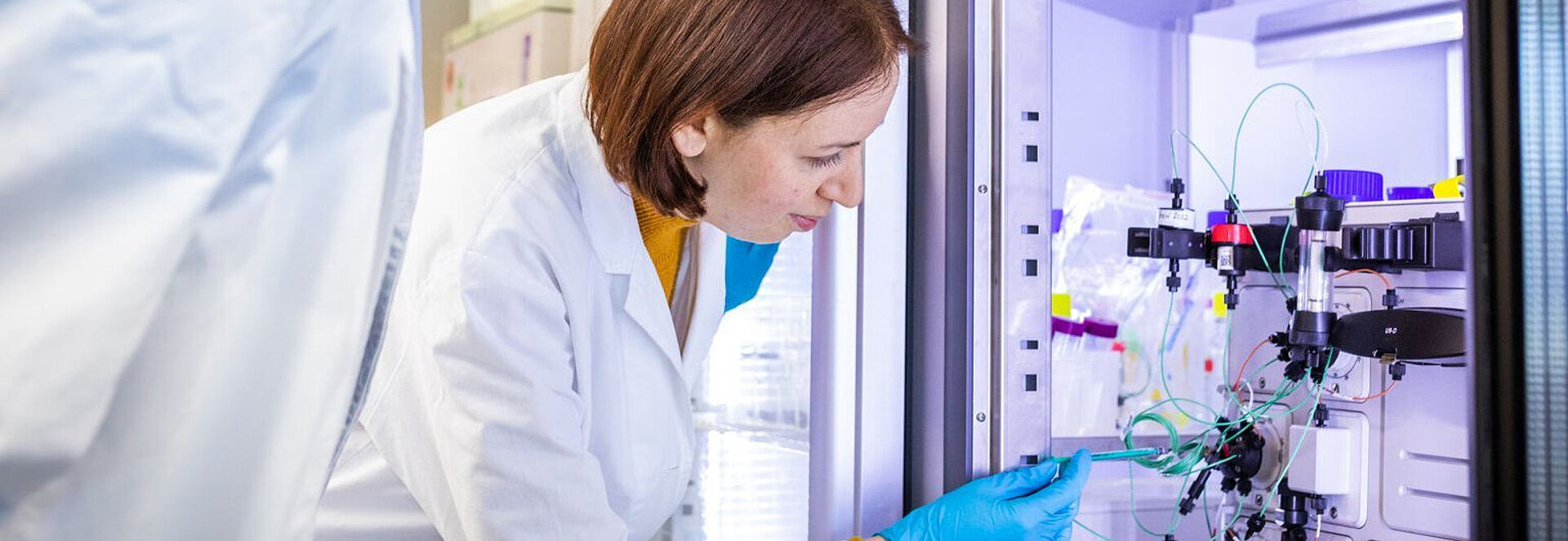Deciphering Regulatory RNAs
DNA is the carrier of all heritable genetic information. This information is read in our cells and used to produce ribonucleic acids (RNAs). Only two percent of all RNAs are subsequently used to build proteins, essential building blocks of life. They are called coding RNAs. Most RNAs, however, are non-coding RNAs and have regulatory functions of various kinds.


Elucidating these regulatory functions and their interactions with coding RNAs is the central research goal of the RNA Biochemistry Research Group led by Prof. Dr. Claus Kuhn at the University of Bayreuth. The group's research extends and deepens the foundations of neuroscience—for example, by providing fundamental insights into the activation of gene expression in stimulated neurons, neuroplasticity and neuronal development.
Young scientists who are fascinated by the functions of RNAs are welcome to join our team!Prof. Claus Kuhn, Heisenberg Professor for RNA Biochemistry at the University of Bayreuth
Enhancer RNAs Regulate Gene Activation
The Bayreuth researchers are carrying out pioneering work into the still widely unresolved question of what functions many types of non-coding RNAs have. For example, they were able to demonstrate that a certain group of non-coding RNAs, known as enhancer RNAs, play a central role in the brain. They activate the transcription of genes that are important for axonal growth and better connectivity of neurons. This happens in an indirect way: enhancer RNAs release RNA polymerase II—Pol II for short—which is responsible for gene transcription, from a large molecular complex that normally surrounds it and blocks the activity that is necessary for efficient gene transcription.


Using neurons as a model system, the Bayreuth research group has succeeded for the first time in demonstrating a direct mechanistic link between enhancer RNAs and the transcription processes, which is a central component of gene expression.
Understanding how enhancer RNAs influence the expression of neurons could advance the treatment of neurodegenerative diseases.Dr. Vladyslava Gorbovytska, biochemist and postdoc in Prof. Claus Kuhn’s research group
The insights resulting from the Bayreuth team's research could contribute to the development of methods to influence neuronal gene expression in a targeted way, and thus to aid the treatment of neurological diseases. In particular, the team is focussing on the function of the "paused elongation complex" (PEC). This is a molecular complex consisting of Pol II and two other protein complexes, which controls the targeted activation of most human genes—not least in the nervous system.
Following initial research successes, the Bayreuth researchers intend to further investigate the influence of enhancer RNAs on this complex. For the structural analyses required for this project the team plans to use, among other things, single-particle cryo-electron microscopy, a technique with which protein complexes can be determined at almost atomic resolution.
Neuronal Plasticity Enables Adaptation to New Challenges
Neurons in the brains of humans and animals are flexible: they can change their functions in such a way that they respond faster and more precisely to changing environmental conditions. Here, too, as has only become apparent in recent years, the activation of gene expression by enhancer RNAs plays a role. This is due to the fact that enhancer RNAs essentially determine the expression of immediate early genes (IEGs). These special genes respond, for example, to electrical stimuli transmitted by nerve pathways stimulated by environmental stimuli: in a flash, IEGs increase their concentrations in neurons.


This increase has a considerable influence on which genes in the nerve cells are transcribed into messenger RNAs, and thus are used for the production of important proteins. In this way, environmental electrical signals are transformed into genetic signals: they promote the development of an embryo's brain, and they give children's and adults' brains the ability to continually adapt to emerging challenges.
Interdisciplinary Cooperation to Understand the Development of Neurons
Prof. Dr. Claus Kuhn's research group is working to elucidate in detail the mechanisms involved in the neuronal plasticity of brain cells. It cooperates in an interdisciplinary way with the developmental biology research group of Prof. Dr. Gerrit Begemann at the University of Bayreuth. The zebrafish, whose embryos are transparent, serves as the model organism for this work.
We can follow neuronal development in zebrafish using imaging techniques, which tells us more about human neurons.Simone Keß M.Sc., biochemist and doctoral candidate at the University of Bayreuth
Bioinformatics Helps Decipher the Basis of Regeneration
Planarians are worms known for their extraordinary ability to regenerate destroyed or severed parts of their bodies—including their neurons. A special group of non-coding RNAs is at play in these processes: piRNAs. These small molecules are activated by protein binding partners that are found in the worms' stem cells, which are essential for their ability to regenerate. Because the proteins bind to piRNAs, the latter are able to recognize and degrade jumping genes, known as transposons. These genes cause mutations because they repeatedly change their place within the genome. As they are degraded by the piRNAs, the genetic information stabilizes, which in turn strengthens the animals’ ability to regenerate neurons.


In humans, piRNAs also have a stabilizing effect on the genome, but they are only present in germ cells. In planarians, however, they are present in large numbers in pluripotent stem cells, which differentiate specifically into a wide variety of cell types: a process that is safeguarded by the degradation of jumping genes. Therefore, these worms are excellent model organisms to help researchers get to the bottom of the mode of action of piRNAs.
Our interdisciplinary research on noncoding RNAs makes use of the latest high-throughput techniques in RNA bioinformatics.Andreas Pittroff M.Sc., bioinformatician in Prof. Claus Kuhn's research group
The long-term goal of the Bayreuth researchers is to elucidate the relationship between genome protection mechanisms and regenerative capacity. With the knowledge gained in this way, research will be able to move closer to the goal of being able to promote and control healing processes within the nervous system much more effectively than is currently the case.



